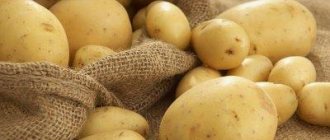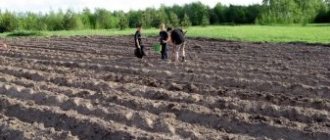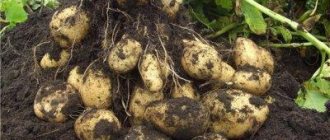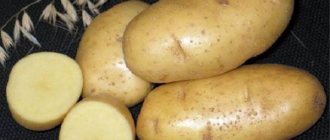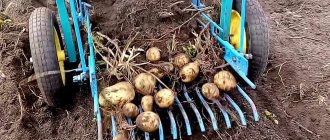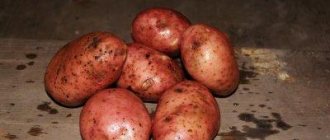Potatoes Skazka: description of the variety and its characteristics
| Variety name | Kolobok |
| general characteristics | table variety of Russian selection with high yield |
| Maturation period | 70-85 days |
| Starch content | 14-17% |
| Weight of marketable tubers | 70-130 gr |
| Number of tubers in a bush | up to 30 |
| Productivity | 300-400 c/ha |
| Consumer qualities | good taste, suitable for frying and salads |
| Keeping quality | 91% |
| Peel color | white |
| Flesh color | white |
| Preferred Growing Regions | Middle Volga, Ural, Far Eastern |
| Disease resistance | relatively resistant to viral diseases |
| Features of cultivation | standard agricultural technology |
| Originator | Selectionnaya LLC, State Scientific Institution Leningrad Research Institute of Agriculture "Belogorka" of the Russian Agricultural Academy |
Medium early variety.
Ripens in 70-90 days, depending on weather conditions. This makes it possible to grow in areas where late frosts are possible. The variety is productive for small farms engaged not only in vegetable growing, but also in livestock breeding. It is recommended to plant potatoes of this variety in fields after growing perennials or winter crops on them. In this case, preference is given to leguminous crops.
The ripened root vegetable is of medium size, the tubers are almost the same oval in shape and weigh from 80 to 130 grams. The skin of the potato is smooth and light yellow in color. In places where eyes form, pink. There are not many eyes, they are not very deep.
When cut, the potato flesh is white. Potatoes with a high starch content are suitable for mashed potatoes or baking; with a low starch content, they are good for frying.
In root crops of the Skazka variety, the average starch content is from 14 to 17%. So in this case, the potatoes are truly fabulous, suitable for soup, for making French fries, they can be fried or baked.
You can see the starch content in other potato varieties in the table below:
| Variety name | Starch content |
| Fairy tale | 14-17% |
| Ilyinsky | 15-18% |
| cornflower | 12-16% |
| Laura | 15-17% |
| Irbitsky | 12-17% |
| Sineglazka | 15% |
| Adretta | 13-18% |
| Alvara | 12-14% |
| Breeze | 11-15% |
| Kubanka | 10-14% |
| Crimean rose | 13-17% |
Features of caring for the variety after planting
Caring for Skazka does not present any difficulties. It consists of necessary and timely feeding, watering, weeding and hilling. Let us consider these agrotechnical requirements in detail.
Important! When planting, half a glass of wood ash should be poured into each hole to stimulate growth and improve fruiting of potatoes.
Fertilizer
In order for potatoes to produce a bountiful harvest and withstand long-term storage well, they need to be fertilized. Feeding is important for the crop due to its weak root system and a large number of tubers of different sizes. Therefore, the correct selection and application of fertilizing is of particular importance. Skazka potatoes need to be fed every 10–15 days. The fundamental rule is to apply fertilizers to moist soil - after a good rain or heavy watering.
Ideally after moistening, but before hilling. At the beginning of the growing season, after the first shoots appear, nitrogen fertilizers are applied: 1 tbsp dissolved in 10 liters of water. spoon of urea; feeding consumption - a bucket for 20 bushes. On the eve of hilling, add a mixture of 1 liter of chicken manure diluted in 10 liters of water.
Did you know? Over 2,000 dishes can be prepared from potatoes.
The mixture is watered exclusively on the roots of the potatoes; any mixture that gets on the leaves is removed. Towards the end of flowering, foliar phosphorus fertilization is done with 1 kg of superphosphate diluted in 100 liters by spraying onto 100 m² of area. This feeding has a positive effect on yield and increases the amount of starch in the tubers.
Watering
Potatoes are extremely sensitive to both deficiency and excess moisture, so timely and adequate watering should be given special attention. Potatoes are watered 5 to 7 times a season, with the first moderate watering carried out after the bushes have formed; the time interval between waterings is 7–10 days. The main sign of the need for watering is the turf drying out to a depth of 6 cm. When watering, you need to saturate the soil up to 0.5 m with moisture; the optimal method of watering is drip; if this is impossible, water it “under the bush.”
Weeding
For normal growth, potato tubers need:
- Air access (aeration).
- Moderate humidity.
- Soft, well-loosened soil.
Many weeds have a stronger root system than potatoes and they grow well in an area prepared for potatoes, while intensively drawing out valuable substances intended for potatoes from the soil, slowing down the growth of the crop. Important! If no protective actions are taken in time, diseases can spoil the appearance of the tubers, or even completely destroy the potato crop.
Weeding allows you to:
- Remove plants that interfere with the normal development of potatoes.
- Fluff the soil, thereby creating favorable conditions for potato tubers to grow.
- Create conditions for access to air and moisture for the tubers.
The beds with the Fairy Tale need to be weeded 3-4 times during the season, and the first time when the sprouts stretch 2-4 cm above the ground.
For weeding you can use:
- simple tools for manual cultivation - for example, hoes, flat cutters;
- cultivators;
- walk-behind tractors
Hilling
Hilling consists of moving soil from between rows to the stems, thereby forming ridges. On the sprinkled section of the stems, secondary roots-stolons grow, which form an additional level of tubers. Potatoes are rolled down twice: the first - 14–15 days after emergence; the second - on the eve of flowering. As a rule, along with rolling, loosening of the soil is carried out.
Better conditions - higher yield
These potatoes are grown mainly in Russia and the former republics of the USSR, Moldova and Ukraine. Productivity depends on climatic conditions and places of growth.
For a good harvest, light sandy and loamy soils are required; it grows well in areas after peat development. In practice, there are examples of successful cultivation on black soils. The variety is drought-resistant ; if there is no rain for a long time, it requires watering, but does not like a lot of moisture.
On heavy soils, the tubers grow small. In favorable conditions it produces a yield of 400-450 c/ha. The variety is classified as a table variety. Used for food. It tastes good. It is considered one of the best in taste.
Potatoes cooked for salads hold their shape well and do not fall apart, fried potatoes have a crispy crust, and the mashed potatoes are airy and tender.
The variety is also good because it has a shelf life of more than 90% . Resistant to diseases and pests. Tubers stored in the fall winter safely and are ready for planting in the spring.
Read more about the storage time and temperature of potatoes, and about possible problems. And also about how to store root vegetables in winter, on the balcony, in boxes, in the refrigerator, peeled.
Also in the table below you can compare the keeping quality indicators of other varieties with Liga potatoes:
| Variety name | Keeping quality |
| Arosa | 95% |
| Vineta | 87% |
| Zorachka | 96% |
| Kamensky | 97% (early germination at storage temperatures above +3°C) |
| Lyubava | 98% (very good), tubers do not germinate for a long time |
| Molly | 82% (normal) |
| Agatha | 93% |
| Sturdy | 97% |
| Uladar | 94% |
| Felox | 90% (early awakening of tubers at temperatures above +2°C) |
Potato agricultural technology and methods for obtaining a good harvest can be very different. On our website you will find a lot of interesting information about growing potatoes. Including about the method in bags and barrels, as well as everything about Dutch technologies.
Also read about growing early varieties, getting a harvest without weeding and hilling, the method under straw, from seeds and in boxes without a bottom.
Collection, storage and use of crops
Harvest in September. A week before harvesting, the tops are mowed to get rid of diseases and allow the root crops to ripen.
The dug up tubers are air dried for 6-10 hours. Then the dried potatoes are sorted, damaged and infected root crops are selected. The harvest is harvested for storage in cellars and basements, where the temperature is maintained at no more than +2°C. Humidity should be 90%. The room is sometimes ventilated, and spoiled tubers are sorted and removed once a month.
This variety is considered universal. It is boiled in its skin and used in salads, purees, and first courses. They also make casseroles.
Photo
In the photo: potato variety Skazka
Reviews about the variety
The Skazka variety is popular among gardeners due to its yield, large and even root crops, rapid emergence, resistance to most diseases, and ease of care. The tubers almost do not boil and do not darken during heat treatment and cutting.
Potatoes of the Skazka variety are universal. Excellent for growing both on a personal plot and in large farms. It is characterized by productivity, keeping quality, transportability and excellent taste characteristics.
Am I the cutest in the world?
Potato Skazka is an annual herbaceous plant. The bush is 60-70 cm high. There are 4 to 8 stems, depending on the size of the tuber. The larger the tuber, the more stems there are on the plant.
One part of the stem is immersed in the ground, the other is covered with dissected odd-pinnate leaves of small size, light green in color.
Flowers are the main decoration of this variety. Large, collected from five petals fused together. The flowers are located on the top of the stem. They have an unusual red-violet hue. When a potato field blooms, it makes a huge impression. The variety is named “Fairy Tale” precisely because of its flowers.
Landing
The pattern and depth of planting potatoes depends on the type of land.
- Light sandy loam soil - dig a hole 10-15 cm deep, a distance between the beds of 25 cm, adhering to a checkerboard pattern.
- Heavy, clayey soil - planting grooves 5 cm deep are cut, seeds are placed in them, and the row spaces are covered with soil. The distance between them should be 60-70 cm, which guarantees sufficient illumination of the beds and facilitates maintenance.
By adhering to the above rules, you will be able to obtain a bountiful, high-quality harvest.
Deadlines
It is advisable to plant Skazka potatoes in early May. The earth should warm up to +7-8 degrees. In the North, planting work can be carried out in late May or early June.
Preparation of the site and planting material
It is necessary to prepare the soil in the fall by adding humus and plowing. Manure cannot be added; its composition often contains weed seeds and emits toxic gases that inhibit the growth of bushes. Humus is added to the soil in a layer of 3-4 cm over the area.
Afterwards, they plow the ground. In the spring, the soil is loosened again, leveling the lumps that appeared after plowing with a rake or mechanized processing with a milling cutter. The earth will become like a homogeneous substance.
Seedlings are prepared a month before planting. Select whole, healthy tubers that have not had their sprouts broken off before winter. They are placed in a warm, well-lit room. Under the influence of light, temperature +15-20 degrees, the tubers germinate. They can be placed in a growth-stimulating solution called Epin for half an hour.
Planting pattern and depth
Skazka potatoes must be planted according to the standard 35*45 cm pattern. Add 1 cup of ash, humus, and 5 g of superphosphate to the holes. After burying the seedling material, the area is leveled with a rake.
Scientists who made the fairy tale come true
The creators of the variety are Russian scientist-breeders N.M. Gadzhiev, V.A. Lebedeva, M.V. Ivanov. from the State Scientific Institution of the Leningrad Research Institute of Agriculture "Belogorka" of the Russian Agricultural Academy, LLC Selection. In 2004, the Skazka variety was included in the State Register.
A distinctive feature of Skazka is that this variety grows a large number of tubers in one hole (multi-tuberism). Not less than 15, but with good care and up to 30 pieces.
The second feature of the variety is that from small nodules of seed potatoes the same yield is obtained as from large ones.
Therefore, if there is not enough seed potatoes, you can safely divide the tubers into small pieces. Germinate them and plant the resulting seedlings on the site.
Growing potatoes is not a complicated process at first glance. But it also has a number of its own characteristics. We bring to your attention useful materials on why herbicides and fungicides are needed when growing potatoes.
Growing and care
The crop requires frequent hilling at the beginning of growth. The first hilling is carried out 2 weeks after germination, the second – after another 2-3 weeks. Early hilling helps increase yield by up to 30%, as it promotes the formation of new roots.
Bushes are watered during the following periods:
- When reaching a height of 10-12 cm.
- At the beginning of flowering.
- After flowering.
The variety does not require fertilizing if the soil has been previously enriched with mineral and organic fertilizers. During the flowering period, weak potassium-phosphorus fertilizers can be applied to increase productivity.
Diseases and pests
Potatoes belong to the nightshade family. Consequently, it is susceptible to diseases and pests of this plant species.
Potato cancer and black cancer - these diseases are not dangerous, the variety is resistant to their carriers.
In rare cases, it falls ill with late blight; more often it is damaged by scab, potato nematode, and macrosporiosis. Viral diseases are transmitted to the plant through the seed fund.
Since the safety of seeds in the Skazka potato is high, if storage conditions are observed and measures are taken to prevent viral diseases, viruses are practically not a threat to it.
Read more about Alternaria, Fusarium, Late Blight and Verticillium.
Pests also “bypass it.” Timely spraying allows you to completely get rid of the Colorado potato beetle, wireworm, mole cricket and potato moth.
Peter I brought potatoes from Holland, Catherine II made a lot of efforts to ensure that they took root in Rus'. Russian scientists are creating new modern varieties that are becoming known and loved by many peoples.
There is not a single country in the world where potatoes are not grown. But nowhere is he loved as much as in Russia. It’s not for nothing that we call potatoes the second bread.
Advantages and disadvantages
- The indisputable advantages of the Fairy Tale are:
- early ripening;
- high productivity;
- good transportability and ability to store tubers;
- excellent taste;
- versatility of use in cooking;
- ease of care;
- resistance to diseases;
- widely used in folk medicine, mainly due to its high potassium content, which allows the body to remove excess salts and water. With the help of Skazka, gastritis and ailments of the gastrointestinal tract are treated; the variety is recommended for heart failure and other ailments.
- The disadvantages of the variety are:
- unsuitability for cultivating two crops in one season;
- low yield and insufficient drought resistance when cultivated in the southern regions.
Useful video
Watch the video: secrets of growing potatoes
And in the table below you will find links to other interesting potato varieties with very different ripening periods:
| Late ripening | Mid-early | Mid-late | ||||||
| Picasso | Black Prince | Blue | ||||||
| Ivan da Marya | Nevsky | Lorch | ||||||
| Rocco | Dark-skinned girl | Rowanushka | ||||||
| Slav | Lord of the Expanses | Nevsky | ||||||
| Kiwi | Ramos | Courage | ||||||
| Cardinal | Taisiya | Beauty | ||||||
| Asterix | Lapot | Milady | ||||||
| Nikulinsky | Caprice | Vector | Dolphin | Svitanok Kyiv | Mistress | Sifra | Jelly | Ramona |
The history of the origin of the “Fairy Tale” potato variety
Potatoes of the Skazka variety were obtained by crossing several varieties - S.tuberosum, S.demissum, S.vernei.
The originator is Selectionnaya LLC, State Scientific Institution Leningrad Research Institute of Agriculture "Belogorka" of the Russian Agricultural Academy. Official registration in the State Register of Russia in 2004.
Zoned for cultivation in the Middle Volga, Ural and Far Eastern regions.
We invite you to familiarize yourself with potato varieties that have different ripening periods:
| Late ripening | Early ripening | Very early | Mid-late | Mid-early |
| Nikulinsky | Borovichok | Forty days | Crane | Yanka |
| Cardinal | Elmundo | Karatop | Sorcerer | Giant |
| Rocco | Felox | Riviera | Mozart | Tuscany |
| Kiwi | Bellarosa | Zhukovsky early | Grenada | Purple Haze |
| Ivan da Marya | Natasha | Farmer | Melody | Openwork |
| Picasso | Ariel | Minerva | Margarita | Santana |
| Asterix | Queen Anne | Veneta | Ramona | Desiree |
| Slav | Arosa | Kiranda | Dolphin | Lady Claire |
Description of Lorch
Considering the fact that the variety was developed when breeding was not so developed, one might think that Lorch has a lot of shortcomings and poor characteristics. But this is far from true.
Lorch is a universal variety with excellent taste and yield. Full ripening of potatoes occurs 120 days after planting.
One bush produces up to 11 large tubers weighing up to 120 g. The average yield is 250-350 centners per 1 hectare of planting.
Tuber characteristics:
- The average weight of a mature root crop is 90-120 g.
- Shell color is yellow.
- The color of the pulp is white. The pulp does not change color during heat treatment and is well suited for processing into starch.
- The percentage of starch content is 15-20%.
- Keeping quality of tubers is 88-92%.
Advantages and disadvantages
The Uladar potato is considered the most promising among other varieties bred by Belarusian breeders. Why? Let's list its main advantages.
- Super early ripeness. The full growing season lasts 70 days, but you can start enjoying young tubers already on the 45th day from the moment they are planted in the ground.
- Double harvest. In the southern part of the country, an attempt to plant Uladar twice in one season will be successful; a high yield is guaranteed both after the first and after the second planting.
- High yield. This is perhaps the most important distinguishing feature of this variety. Under favorable conditions, up to 60 tons of high-quality potatoes can be harvested per hectare, and this is not the limit. A record was recorded when Uladar produced as many as 71 tons of selected potatoes from one hectare!
- Unpretentiousness. The variety easily tolerates periods of summer heat; it is completely undemanding to the soil. But still, preference should be given to soils with light or medium texture; on heavy ones, the yield will noticeably decrease.
- Application. Uladar is considered a high-quality table variety. It is excellent at transporting over long distances, so it is often grown for export to other countries. These potatoes also store well and can be used until the next harvest.
- Excellent taste. Potatoes have a pleasant taste and aroma and do not become soggy when cooked. If you fry the pieces in olive oil or goose fat, they will acquire a crispy crust, while the flesh will remain tender, almost melting in your mouth.
- Resistance to certain diseases. Uladar rarely suffers from potato cancer, is not afraid of nematodes, and is not afraid of wrinkled and striped mosaics.
The only significant drawback of the variety is that it is sometimes affected by late blight (both tops and tubers); in addition, in dry conditions the leaf curl virus can appear. In all other respects, this potato does not cause any complaints.
